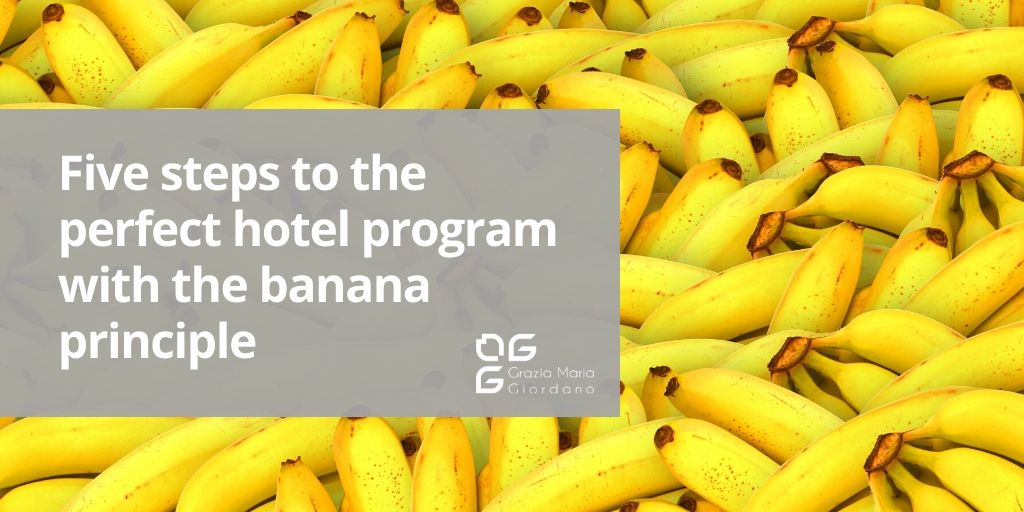Hotel spending is one of the most elusive areas of Business Travel: a very fragmented and dynamic industry, lacking global standards. Couple it with the trend of Travelers booking outside the preferred channels, and any initiative to get the Hotel Program under control becomes a daunting task.
What are then the solutions available for companies who aim at a Hotel Program, which doesn’t exist just on paper but it’s used and produces the expected results?
My reply to this challenging question is straightforward: use the Banana Principle.
The Banana Principle gets its name from the fact that people tend to choose bananas over another kind of fruits, merely because they are easy to peel.
The Banana principle can be used in several contexts, such as to reduce friction in change programs, improve cross-team collaboration, and reconfigure office space to foster specific behaviours.
Hotel programs also benefit enormously from the application of the Banana Principle.
The improvement of hotel compliance, the reduction of leaks in the program, and the achievement of the desired savings are not something you can attain just merely asking people to comply.
It is pivotal, then, to create the best conditions so that your employees are compelled to use the program.
How can we achieve the best “banana” hotel program?
I’ve identified the following steps.
-
Start with the Traveler in mind
Not everyone is the same
Nowadays, Travelers want more personalised experiences. They want their needs and preferences to be taken into consideration. Hence, one-size does not fit all.
The starting point when creating a hotel program based on individual needs that leads to a rewarding experience is a deep understanding of individual Traveler behaviour.
To achieve such knowledge, my suggested approach is to combine quantitative data coming from all the available sources (booking tools, payment systems, TMC data, HR data) with a more qualitative approach based on Design Thinking. Empathy interviewing, the creation of “personas” (or archetypes summarising the critical characteristics of a specific group of people) the drafting of a Traveler’s journey may offer a robust approach to understand what their needs and wishes are.
-
Know your geography
Your business changes, so also the hotel program should change
When, some years ago, I redesigned the hotel program of the company I was working for, my first step was to understand where my colleagues were spending their hotel nights, but most importantly I wanted to know why! My objective was to clarify if the historical data I had, could be used for a reasonable forecast for the future.
The key message is that you should stay abreast of any business changes that could affect your hotel program, such as new projects in specific geography, a new client, a new regional office or general developments in the business, which could lead to a drastic change in the hotel night patterns.
Historical data won’t be enough: you’ll need your intelligence network and conventional processes within the organization, which will allow you to get the information when you’ll need it. You’ll ensure then that the hotel program will have the right properties in the right geographies!
-
Adapt your sourcing strategy
Yearly RFP, Continuous sourcing and hotels aggregators
Changes in the business and change in the industry might render the traditional annual RFP process entirely obsolete.
The inherent complexities of the industry, such as high fragmentation, lack of industry standards, steady consolidation process paired with the emerging trend of chains to adopt airline-style yield-pricing make very difficult to stay on top of the movements in the industry.
In these conditions, securing the best rates within a yearly RFP is not always possible.
Besides the industry trends, one of the issues with traditional yearly RFP is the effort required to run the process. Research (ACTE – New approaches to Hotel Sourcing – October 2017) shows that 60% of the Travel Managers dedicate more than 50hrs/year for the set-up of the process, and other 50hrs/year for the maintenance of the hotel program! By the time it’s done, it’s likely that the original needs have changed and time and resources have been wasted to secure properties, which are not any longer needed.
Two different approaches can help organisations to achieve a better hotel sourcing strategy: outsourcing and continuous sourcing.
The outsourcing of the Hotel Program, also made possible by the rise of industry market aggregators, has the valuable benefits of ensuring a wide choice of properties at the best price without the time commitment and effort required by managing your RFP. In addition to the increased coverage, companies get better and up-to-date local knowledge through outsourcing. In this case, you can always be sure your employees will have the properties they need where/when they need it. Someone else is creating a comprehensive, flexible portfolio of properties and their high volumes will also ensure better rates.
The features of the providers of this kind of service make this scenario possible for organisations of any size.
The second tool is “Continuous Sourcing.” Continuous Sourcing means that hotel dealings run throughout the year. Researchshows that adopters of Continuous Sourcing can get savings with more frequent negotiations, where the traditional yearly RFP misses too many savings opportunities. Change in usage patterns and new business trends can be regularly factored in the negotiation. At the same time, Continuous Sourcing improves the program flexibility and in the end the Traveler’s satisfaction.
Depending on your organisation’s usage patterns one of the three approaches or a mix of them can solve all your problems around the hotel program.
-
Provide the right tools
Make it easy and convenient to find and book the hotel your employee needs
Whenever I speak to business Travelers their reactions are more or less the same: yes there’s something on the Intranet, but I find it easier to look myself on the Internet and then I send my request via e-mail to our Agency!
Booking is often a real pain for Travelers. A recent survey shows that one out of three Travelers think that the search and booking process is too long and frustrating and they spend too much time in trying to find the best price. Further to that different type of Travelers (or Personas from point 1) might have different needs and perspectives. This is why multichannel approaches accessible from various devices cater better to the needs of the connected business Traveler
-
Set clear rules and communication
Open a two-way communication channel with your Travelers
To make sure the hotel program is used, rules need to be clear. Can a person choose something outside the allowed sources? Are there limitations/possible exceptions? Keep in mind that you’re trying to provide your employees with a Banana Principle Hotel experience: the easier, the better. Widespread and regular communication about your hotel program and the chosen approach is another crucial moment. Make the information available in a way your employee can use it. Explain what objectives you want to reach, and why you’ve chosen a strategy over the other.
Don’t hide the information in the remotest page of your Intranet, don’t make access less appealing by introducing the umpteenth password. Understand what your Travelers’ information needs are and present the information in a way that is easy to get. Researchshows that almost 30% of Travelers think that there’s too much and confusing information! Forget the 30 pages travel policies and go for something more accessible and digestible.
Last but not least, ensure your Travelers can give their feedbacks. The Hotel Program manager can not physically know all the properties used by her colleagues around the world, but it’s vital that feedbacks, and action is taken when something doesn’t work. The feedback will allow for a continuously updated knowledge about the properties, and people will also grow the feeling they are heard and understood.
The benefits of a “banana” hotel program are several for all the parties involved:
- For the Business Traveler as she will always be able to find a property which fit her preferences while complying with the company’s travel policy
- For the HR Manager, as the employees will more easily comply with the plans, they will be much happier with likely positive effects on engagement
- For the CFO as costs will be more under control and more dynamically managed
- For the Travel Manager as she will provide the company with a hotel program fitting with company needs at the best possible prices
Are you ready to transform your hotel program?






